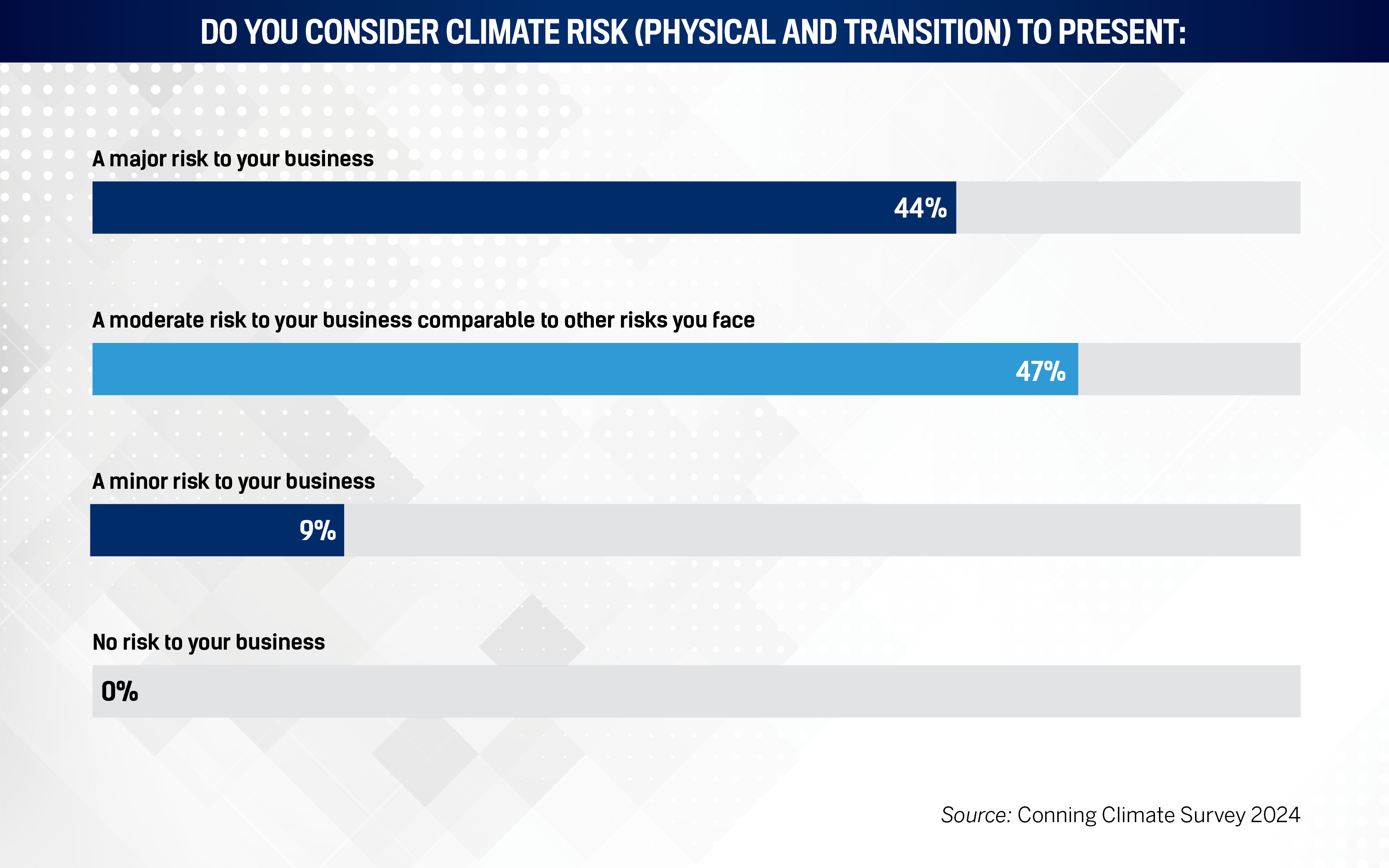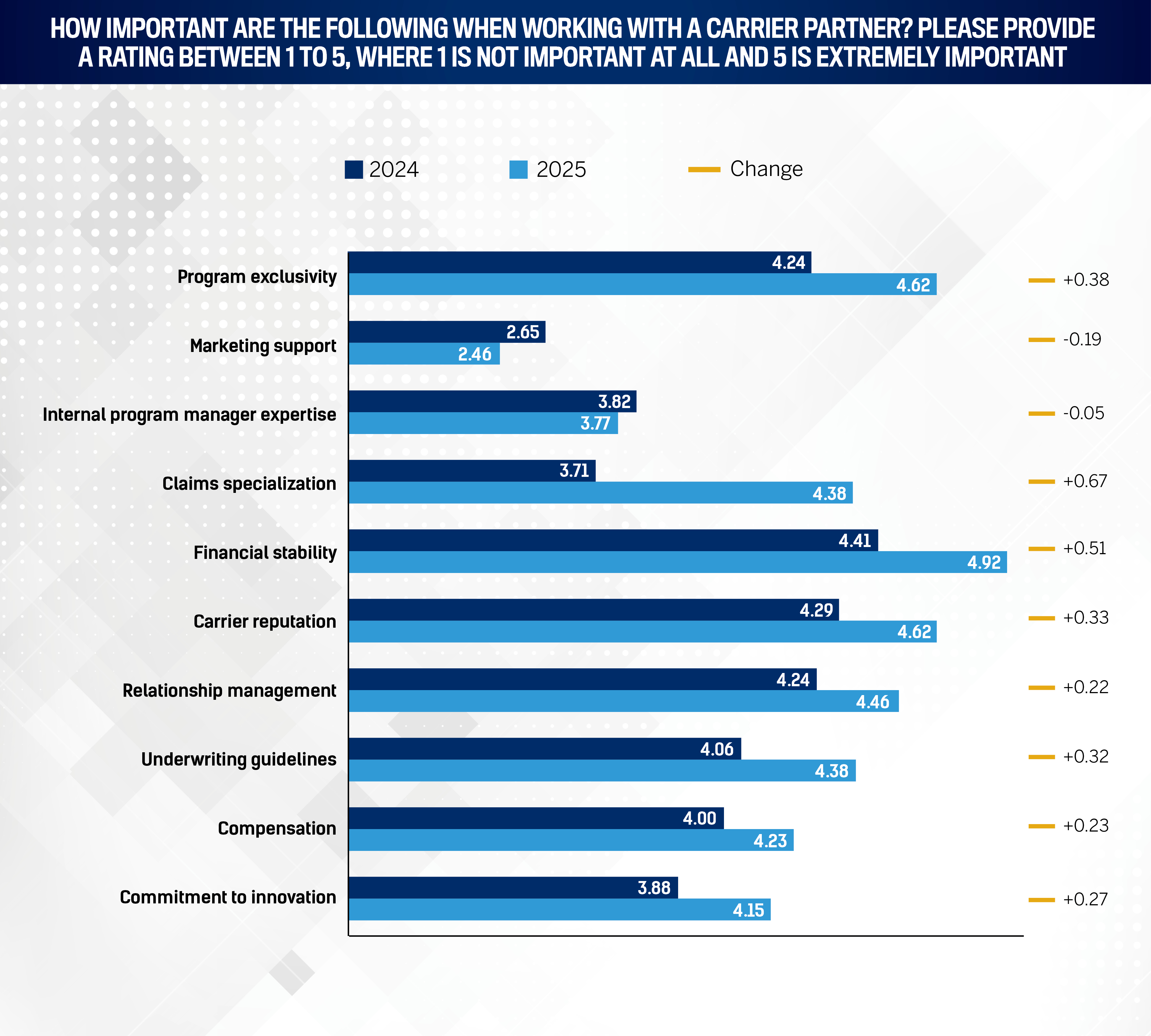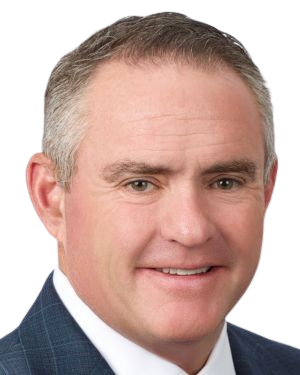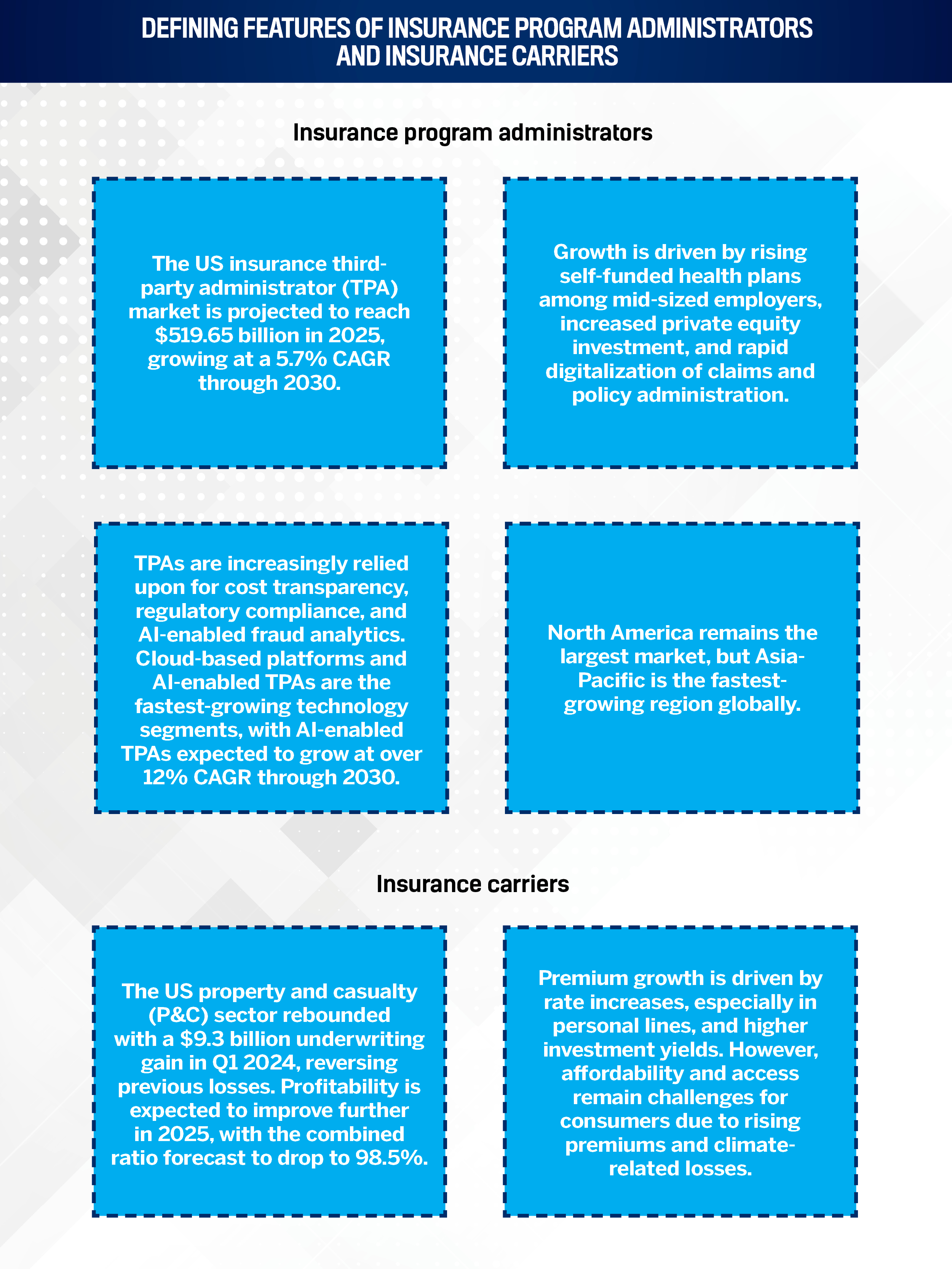Jump to winners | Jump to methodology
Anticipating tomorrow: blueprint for growth
It’s prime time to be an insurance program administrator (PA) and carrier in the American sector, as these firms can best show their true worth by anticipating what is coming next and building programs in that direction. Success depends on agility, investment in digital transformation, proactive risk management, and a strong focus on compliance and sustainability.
The best in the business are reaping the rewards of specialization, agility, and long-term vision by building for scale, investing in data, and ensuring their underwriting is on point.
The Target Markets Program Administrators Association Mid-Year Meeting 2025 concluded that the segment continues to outpace non-program commercial insurance in growth.
But the shift isn’t happening evenly because, while property is softening, liability remains constrained due to a burgeoning litigation environment where larger settlements occur.
Geography of risk is also changing as what were once fringe exposures, such as wildfires and hurricanes, are now central to underwriting conversations.
These factors demand that industry leaders develop a broader view.
“We can’t just build programs for the past – we have to anticipate what’s next,” says Jennifer Burnham, division VP at Great American Alternative Markets.
Insurance Business America recognizes the most resilient program administrators and carriers through extensive surveys and research.
Program administrators were ranked based on their achievements and initiatives across a range of areas, including the largest programs, expertise and stability, and innovations in program development. Program administrators were also asked to provide feedback on the carriers they work with.
Together, they are recognized by IBA as the 5-Star Program Administrators & Carriers 2025.
A range of factors are impacting the decisions and strategies of the leading insurance program administrators and carriers.
1. Technology and digital transformation
-
AI and automation: Over 75 percent of US insurers have implemented generative AI in at least one business function. AI is widely used for claims processing, risk assessment, fraud detection, and customer service, driving efficiency and reducing costs. AI-driven anti-fraud solutions are expected to save the industry tens of billions by 2032.
-
Cloud adoption: Cloud-based platforms now account for half of all third-party administrator (TPA) deployments, enabling scalability, integration, and real-time data access.
-
Embedded insurance: The distribution of insurance at the point of sale (e.g., via real estate or automotive platforms) is rapidly growing and projected to exceed $722 billion globally by 2030.
-
Deloitte research suggests that AI can provide US$4.7 billion in annual growth, demonstrating the immense opportunities to be capitalized by US providers and carriers.
-
Deloitte also suggests that between $80 billion and $160 billion in fraudulent losses could be avoided by insurance carriers adopting preventative anti-fraud technologies by 2032.
2. Customer expectations and personalization
-
Digital-first experiences: Customers expect seamless, digital-first experiences, self-service options, and highly personalized products. Insurers are investing in modern platforms to meet these demands and improve loyalty.
-
Personalized products: Usage-based and behavior-based insurance models are on the rise, enabled by AI and real-time data analytics.
3. Regulatory and compliance pressures
-
Climate risk and transparency: Regulatory focus is intensifying on climate risk, cost transparency, and value-based administration, especially in property and health lines.
-
Data privacy: Evolving data privacy regulations and new global and US tax rules (e.g., Pillar Two, CAMT) are increasing compliance complexity for program administrators.
4. Climate and catastrophe risk
-
Rising claims: Natural disasters and climate-related events are driving up claims and premiums, especially in property insurance. Insurers are under pressure to develop new risk models, incentivize resilience, and collaborate with governments and communities.
-
Climate risks – A 2024 report by Conning shows 91 percent of insurance executives view climate change as a major risk to the insurance industry, with 60 percent of respondents planning on implementing climate risk analysis tools into their business to address the increasing threats of losses from climate-related events.
-
Insurance executives expressed grave concern over the transitional effects of climate change, with 96 percent of respondents agreeing that these risks will have an impact on their business decisions over the next decade.

5. Cybersecurity and data governance
-
Cyber threats: Cyber risks are a top concern, both as a direct threat to insurers and as a coverage area for clients. Investments in cybersecurity, data governance, and compliance are critical. The rise in ransomware and third-party breaches is leading to stricter security regulations and more robust cyber insurance offerings.
6. Market growth and dynamics
-
TPA market growth: The US TPA market is projected to reach $519.65 billion in 2025, growing at a 5.7 percent CAGR through 2030, driven by self-funded health plans, private equity investment, and rapid digitalization.
-
Profitability and competition: The property and casualty sector rebounded with a $9.3 billion underwriting gain in Q1 2024, with profitability expected to improve further in 2025. However, affordability and access remain challenges due to rising premiums and climate-related losses.
7. M&A and market consolidation
-
Private equity and consolidators: M&A activity is robust, especially in property and casualty and distribution. Larger platforms are emerging, able to negotiate better provider discounts and navigate complex regulations.
8. Sustainability and ESG (environmental, social, governance)
-
ESG integration: Insurers are increasingly integrating ESG factors into underwriting, operations, and product development. Climate change mitigation and sustainability reporting are becoming standard practice.
9. Talent and workforce transformation
-
Skills gap: The industry faces a talent crunch, especially in digital and AI skills. Upskilling, flexible work arrangements, and talent retention are strategic imperatives.
10. Emerging risks
-
New risk types: Risks such as PFAs (“forever chemicals”), AI liability, and geopolitical instability are gaining prominence. Insurers are developing new products and risk models to address these emerging threats.
IBA data on Insurance Carriers and Administrators winners

Insights
-
Risk and reliability factors (financial stability, claims specialization, carrier reputation, exclusivity) have become significantly more important in 2025.
-
Operational and relationship factors (relationship management, underwriting guidelines, compensation, innovation) also increased in importance, but to a lesser degree.
-
Marketing support is the only factor to see a notable decline, suggesting a shift away from marketing toward core operational and risk management priorities.
-
Overall, program administrators are prioritizing stability, expertise, and trusted relationships with carriers more than ever in 2025.

Insights
-
The largest improvements were in areas previously rated lower (marketing support, claims specialization, innovation), indicating carriers responded to prior weaknesses.
-
Core strengths (financial stability, reputation) remained strong and improved slightly.
-
The gap between the highest and lowest scores narrowed, suggesting more consistent carrier performance across all criteria.
IBA’s 5-Star Program Administrators & Carriers 2025
Largest programs: primary, commercial general liability
-
Proactive anti-fraud action
-
Significant claims savings: Closed nearly 650 fraudulent claims with zero payouts, saving insureds millions of dollars.
-
Meticulous investigations: Over two years, each claim was thoroughly investigated, uncovering inconsistencies such as exaggerated symptoms and hospital records showing no injuries.
-
Collaborative approach
-
Data-driven insights: Detected patterns like plaintiffs sharing addresses, repeat claimants, staged accidents, and suspicious medical billing, enabling both defense of current claims and prevention of future fraud.
-
National recognition
-
Industry leadership
-
Strengthened client trust
Roosevelt Road Specialty has spent the past two years investigating the endemic problem of fraud in construction insurance.
CEO Dan Hickey Jr. claims that over 60 percent of labor law claims being unwitnessed, unreported events are meant to dupe contractors and their insurers.
After dedicating large amounts of time, resources, and staff to sniff out fraud, Roosevelt’s results have led to a profile and contractors seeking the firm’s services.
“Any time you have to spend the time and money on anti-fraud like we have, that’s an investment you make up front with a return on the other side,” Hickey says. “We’re very confident in the way that’s proceeding and quite honestly all of the notoriety that’s come out of that has really increased our submission flow and contractors wanting to do business with us.”


“We only enter a niche industry if we think there’s a need for exceptional claim mitigation and loss control. If it’s a transactional line of business, you’re not going to see us involved”
Dan Hickey Jr.Roosevelt Road Specialty
Contractors have praised the firm for stepping up and defending them, as they often struggle to purchase liability insurance due to the amount of incidents on worksites. Hickey and his team deliver by often removing obstacles that contractors face in accessing liability insurance.
Hickey explains, “With these fraudulent cases, it eventually can make a qualified contractor uninsurable. They’re aware of that, and they know when it comes to putting a flag in the ground and deciding to fight it. Nobody’s doing it with the intensity and the capability we are.”
The firm went so far as to send undercover workers to identify fraud, leading to the filing of RICO lawsuits, while plaintiffs have been withdrawing large volumes of cases due to the known diligence of Roosevelt.
“We saw illegal OSHA classes being run to teach illegal immigrants on the recruitment and deploying these people into work sites,” Hickey explains. “We’ve had over 700 labor law cases withdrawn prior to getting in a courtroom.”
Roosevelt’s aggressive moves to combat fraud are rooted in Hickey’s conviction that fraudulent activity must be rooted out for insurance markets to continue moving forward. He says, “It’s not sustainable for markets to absorb these illegal losses.”
With the reputation Roosevelt has built to combat fraud, clients remain confident in their deep commitment across the board. Hickey says, “Pricing is within a bandwidth of your filings and your schedule credits and merit credits. We know where we want to price. The real value comes in avoiding fraudulent claims and keeping losses down for an insured to improve pricing in the long run.”
According to Hickey, Roosevelt’s relative lack of bureaucracy allows the firm to adopt AI and other technologies swiftly.
“We’re not going to put it through a bureaucracy to get it in motion. If we believe in it, we’re going to use it,” he says.
One example of Roosevelt’s forward thinking has been its adoption of AI mandatory dashcam technology in its auto policy. It has made proving claims infinitely easier, further dismissing potential fraudulent issues.
Hickey explains, “We’ve already had death claims that were completely able to show that the individual ran a red light and we’re not at fault. Without that technology, we’d be in there defending what would be a bogus claim.”
Roosevelt’s use of innovative technology extends to the assisted living sphere, where staff can be aware of potentially dangerous incidents for senior residents.
“We can monitor patient movement and help prevent those patients from getting injured. At night is typically when they get most confused.”
Hickey also emphasizes Roosevelt’s flat structure, which makes cooperation between underwriting and claims and loss control departments.
“There are no silos between underwriting, claims, and loss control. We’re integrated and communication is high,” he explains. “The underwriting team works very closely with the other teams to get the granular information they need on an account to make a better decision on how to price it.”
Largest programs: Residential real estate, investment property program, GCGuard for artisans and general contractors, InkShopGuard for tattoo shops and artists
-
Custom technology platform: Enables agents to propose, bind, issue documents, and service investor clients directly, unless flagged for underwriting review.
-
Agent empowerment: Agents can manage portfolios, process endorsements, add subagents, and access commission reports through the platform.
-
Integrated billing and payments: System tracks and applies prepaid and escrow funds, managing all billing and payment processes.
-
Automated underwriting: Each location is fully underwritten before quoting, eliminating post-bind inspections, cancellations, or rate changes.
-
Internal dashboards: Robust dashboards help internal teams manage contract capacity, risk profiles, and geographic growth, supporting fast decision-making and business growth.
-
Unique monthly reporting
-
Flexible controls: Technology enforces underwriting guidelines across multiple carrier contracts while allowing agents to respond quickly to investor needs.
-
Innovative investor solutions
Remaining vigilant by assessing climate disaster risks is a priority for REInsurePro, which uses information from websites, such as Frontline Fire and Watch Duty, enabling the company to determine how many clients are at risk of being impacted.
“Being able to understand what’s actually going on and using technology to identify and then try to pre-emptively protect everyone have been really important,” SVP for risk management Jason Jones explains. “We use different resources to identify whether a wildfire has spread, whether it’s contained, how much that may affect some of our clients. We then give our marketing group an opportunity to then reach out to some of those clients.”
The firm also uses underwriting tool HazardHub, which gives users a location-based score on risks such as wildfires and crime, providing REInsurePro’s underwriting team with the data needed to compile a complete assessment.


“A lot of the partners that we start to do business with are referrals or are interested because they’ve seen our business model work for the marketplace”
Jason JonesREInsurePro
“We identify what particular area may be affected, then we create the different type of information that we feel is useful for them, then use that to hopefully allow them a better opportunity to get through that unscathed,” says Jones.
The volatility in the US market during 2025 prompted REInsurePro to pivot away from saturated markets in search of underserved regions, including Montana, South Dakota, and Utah. Its wide network of carriers along with a reputation for excellence has allowed the firm to grow into these untapped regions.
Jones explains, “We’ve tried to create a larger footprint in the northwest and some of those areas that may be underserved.”
A high client retention rate demonstrates reliability that sets REInsurePro apart. Its wide range of services holds large appeal, as the firm is comfortable taking on large-scale and smaller-scale tasks.
“We’re a unique product,” says Jones. “We serve tens of thousands of different accounts daily for things as simple as EOI requests all the way up to adding a new location, so we use all of that to then give the clients comfort to say, ‘We’re here for you.’”
There is an emphasis on “a la carte” services where clients manually choose specific coverage. This approach has been successful, particularly as economic concerns have elevated across the country.
Meeting market needs with innovation
IBA’s 5-Star Program Administrators and Carriers 2025 winners stand out for their ingenuity and responding to demand.
For the past three years, RPS has established and staffed a new Product and Business Development department with the aim of identifying mutually beneficial opportunities for RPS Signature Programs among carriers, clients, and insured individuals. The organic growth initiatives concentrate on capitalizing on market opportunities and addressing market needs by aligning business strategies, financial plans, and new program submissions with the objectives and appetite of the firm’s (re)insurance partners.
The product function incorporates three key components:
-
Market research: Both primary and secondary research to gain insights into the dynamic market conditions, needs, and trends.
-
Product strategy: Working closely with subject matter experts, we develop comprehensive go-to-market strategies and program submissions.
-
Product implementation: The team oversees the organization of RPS resources and ensures the successful delivery of new solutions to the market.
The RPS Business & Product Development function reports to the RPS Programs Division leader for the sole purpose of driving innovation and growth in new and expanded programs. This is accomplished through consistent interaction with a broad set of producers, clients, carriers, reinsurers, technology providers, and other industry thought leaders. In terms of resident insights, RPS is an expert-driven organization that interacts with more than 25,000 agents on a daily basis to meet the needs of insureds.
This knowledge is collected, triaged, summarized, and communicated in regular line of business meetings, project-specific primary market research, white papers, interviews, and articles. RPS collects, mines, and analyzes production data to understand buyer behavior and detect new areas of opportunity. The firm makes a concerted effort to access external industry thought leaders through participation in conferences, panels, and the like.
In 2024, these methods identified and advanced multiple new program opportunities as well as enhancements within established programs. Achievements include new solutions to address the changing market for property insurance through the development of an in-house facility, private commercial flood insurance solution, and the adoption of alternative sources of capital. Future initiatives continue to focus on other solutions to address the impact of climate change/extreme weather volatility: wind, wildfire, and earthquake.
RPS also continues to emphasize the development of digital insurance programs. New digital programs for small business, contractors, transportation companies, and more leverage the ability of RPS’s in-house platform to employ application/data ingestion, algorithm-driven underwriting, automated rating and issuance to efficiently deliver insurance solutions and subject matter expertise to its clients. To date, the platform has transacted more than $400 million.
The firm launched a unique program offering a monthly reporting schedule across a broad range of property types and occupancy statuses with seamless changes. REInsure’s technology platform allows it to put the appropriate controls in place to manage underwriting guidelines across multiple carrier contracts, while also giving appointed agents the ability to quickly respond to the unique needs of their real estate investor clients.
The newest program for investors is FlipShield, which responds similarly to a General Contractor’s liability coverage for house flippers that are not licensed contractors but may be performing some or all of the renovation work. This protects the DIY investor in case of property damage or injury that may arise as a result of the renovation process, including Products and Completed Operations for up to one year after the policy’s expiration. This helps fill a coverage gap for house flippers that Premises Liability does not cover.
SCIS has demonstrated expertise in underwriting and pricing temporary staffing accounts, which currently represents about half of the firm’s in-force business. In 2024, SCIS launched a program to provide workers’ compensation coverage to the underserved security guard marketplace for both armed and unarmed guards.

Program Administrators
- Great Lakes General Agency
- McNaire Underwriters
- MiniCo Insurance Agency
- US Assure
- Venture Insurance Programs
- Veracity Insurance Solutions
Carriers
- Allied World
- Clear Blue
- EAIC
- Great American Insurance Company
- GuideOne
- Liberty Mutual
- Munich Re
- QBE North America
- SCOR SE Insurance
- Third Coast Insurance Company

Leave a Reply